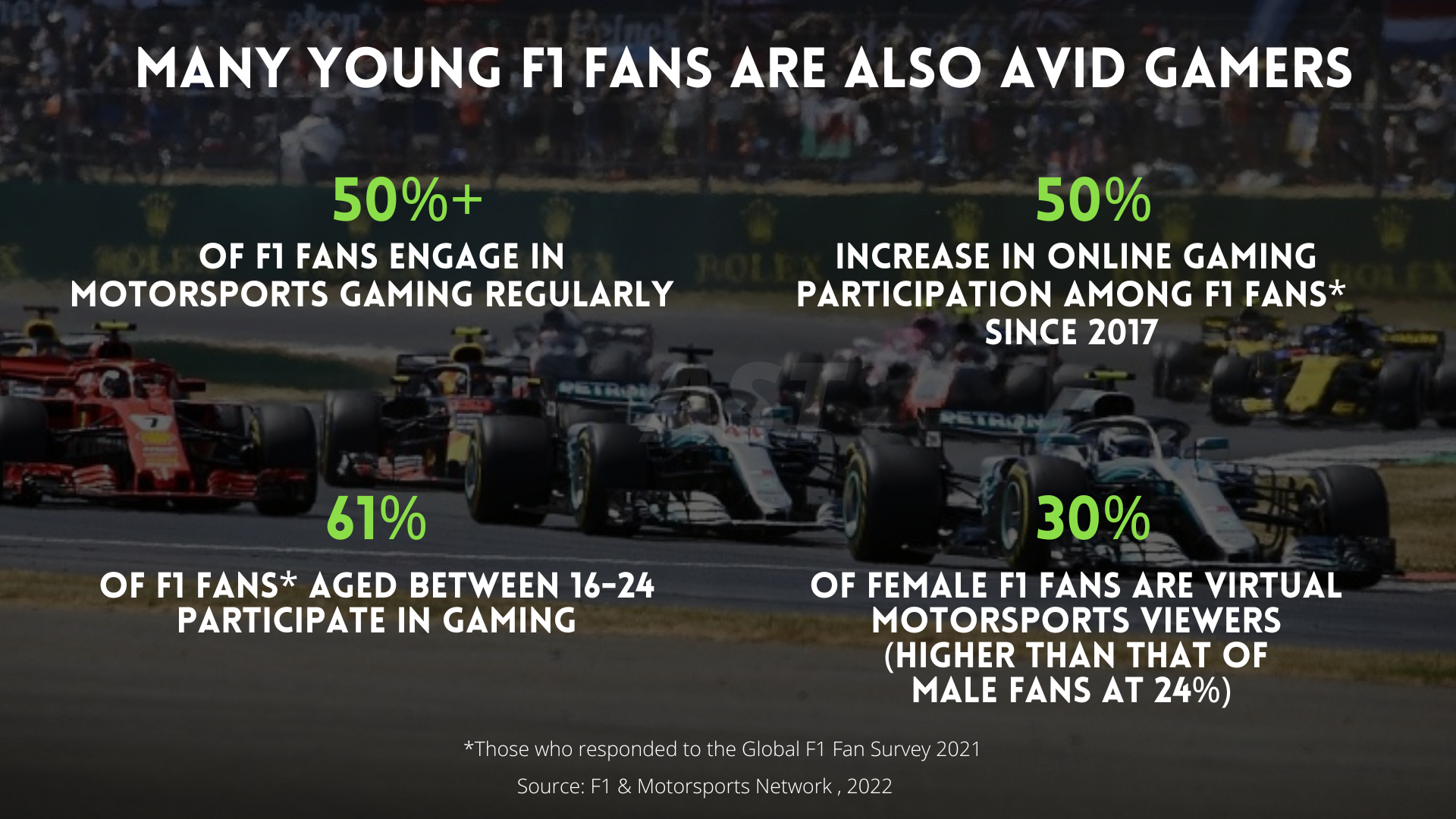
The Singapore Grand Prix, the most anticipated Motorsports event in Asia, is just around the corner. In regards to that, AST decided to dig deep into the development of motorsports in Asia and how the region is favorable for Sim Racing to grow.
Sim Racing has greatly accelerated during the pandemic. According to Grand View Research, the global gaming simulator market size will grow 2 times from 2020 – 2027, rising from US$4.5 billion to US$10 billion at a CAGR of 12.1%. The advancement in simulation tech has allowed Sim Racing to deliver a truly immersive driving experience.
The rise of Sim Racing has already created crucial new avenues for motorsports teams, esports teams, event organizers, automobile brands, and game developers. However, Asia offers opportunities for transformative growth and profitability for sim racing which we will explain in detail below.
Asia saw steady growth in motorsports
Motorsports has been growing at a healthy rate in Asia over the decades with many world-class motorsports events taking place in the region regularly. In 1976, Japan became the first Asian country to host an F1 race, followed by Malaysia, China, Korea, India (home to former team – Force India), and Singapore (the very first night race in F1 history). The Japan GP was recognized as one of the “Popular Perennials” while the Singapore GP was recognized as one of the “New Favorites” as indicated in the F1 Fan Survey 2021. MotoGP has also taken place in several Asian countries as well with many powerhouse teams (Honda, Yamaha, and Suzuki) hailing from Japan. India is set to host its maiden GP in 2023.
There were other notable races taking place in Asia such as Formula E in Hong Kong from 2016-2019 & the Macau GP (first launched in 1954) remains significant in the world of professional racing and the development of multiple Asian racing series I.P.
AST asked Matthew Marsh of GoF1 Show Presenter and an expert in the Asian motorsports arena, to share his insights with our audience. Marsh stated: “ The growth of motorsports in Asia has stabilized over the years. The Chinese Grand Prix started in 2004 and F1 has been growing gently, the growth is slow but decent, and now there is a large number of avid fans in China. Domestic motorsport was growing in China but mostly at an elite level. It’s also popular in Japan as the country has a significant motorsport economy.”
In recent years, we have begun to see some Asian faces on the F1 starting grid like Zhou Guanyu, the very first Chinese driver who made it to F1 and Yuki Tsunoda, the Japanese driver who races for Scuderia Alphatauri. As AST has pointed out in the past: Asian representation, in any sport, is a sure-shot way to further grow interest in motorsports and create more opportunities for F1 to engage and grow their fan base in Asia.
There is also increasing representation for Asian women in motorsports. Drivers such as Betty Chen, a 22-year-old who was the first driver from Taiwan to race in the British GT championship and Keiko Ihara, one of the first women in Japan to become a top racing driver.
Marsh highlighted that the Liberty Media acquisition of F1 and the Netflix Series “Drive to survive” is extra significant in F1 history, and he sees the potential of launching a local television product in Asia: “Localization is key to growing its fan base in Asia: like a local TV Show. Local brands sponsoring these shows will go a long way, like what NBA did in China. Or to stream F1 on free-to-air TV in countries where they have a large fan base.” said Marsh.
Marsh also pointed out that to further grow motorsports, there needs to be a distinction between a TV sport versus a participation sport, while agreeing that growth in interest in F1 does drive participation in motorsports.
It is believed that the coming years will continue to be very exciting for Asian motorsport which is creating great momentum for motorsports. Yet, the development of young drivers remains an issue that hinders the growth of Asian motorsports. A lot more can be done on a grassroots level as the system is still not quite as sophisticated compared to Europe, resources are limited and it is very expensive. Asian drivers often need to travel to Europe to train and compete if they aspire to race professionally.
Sim racing could be the ideal technological breakthrough that bridges this huge gap, especially when it comes to driver training.
Simone Cunati, Co-Founder and COO of Teleios and 2020 World Karting Champion, told AST that when he realized that no ideal car simulators were available in the market, he was urged to build Teleios; a luxury car simulator brand that blends performance, technology and design.
Simone is very confident about the prospects of sim-racing: “Sim-racing will be massive, for real drivers as well. It will be a key path for people to enter motorsports and will potentially replace traditional paths like go-karting. In 5-6 years, about 50% of professional drivers will come from sim-racing as it is more accessible and affordable; it will attract more talents to pursue a career in motorsports.”
Watch Teleios’ panel at All That Matters

Teleios x Supercar Blondie
Asian consumers love splurging on luxury cars
Asia’s luxury car market will continue to thrive in the future as the demand for cars (in particular supercars) and the purchasing power of prospective car buyers remain very strong.
According to McKinsey’s five trends shaping tomorrow’s luxury car market, APAC is expected to have the highest growth in the global luxury market between 2021 and 2026, one key factor would be the increase in Ultra-high-net-worth Individuals (UHNWIs) and High-Net-Worth Individual (HNWIs). The percentage growth of the UHNWIs population in Asia is 33%, which is higher than the US and Europe with 28% and 27% respectively.
China will be a crucial growth engine for the global luxury car market. According to data from China Passenger Car Association, in 2021, the cumulative sales of luxury cars stood at 2.65 million units; a year-on-year increase of 5%. Lamborghini has consistently demonstrated strong growth momentum in recent years and has attached great importance to the Chinese market, the second largest market for Lamborghini in 2021.

On the other hand, around 17,000 luxury vehicles were sold in the first half of 2022 in India – an increase of 55% over 11,000 units sold in the year-ago period. Lamborghini sales grew by 86% and have set a new all-time sales record with 400 sold in 2021. In South Korea, the number of supercars bought by corporations has quadrupled from 1,172 in 2016 to 5,075 units in 2022 according to the National Assembly Budget Office.
Many luxury automobile brands have already started tapping into the motorsports and sim racing market as they realize the potential for them to increase their brand exposure and allow them to demonstrate their tech and products and to better engage with current and potential customers. For example, Porsche has a Formula E team, Audi’s F1 team will be debuting in the 2026 season and Lamborghini also launched their own esports team earlier this year.
As Asia is becoming a dominant market for luxury automobile brands, affluent car lovers in Asia will make an ideal consumer segment for sim racing developers to monetize on.
Many young Asian motorsports fans are also avid gamers
Many motorsports fans are also very active in gaming these days, especially the younger ones.
According to the “2021 F1 Global Fan Survey” by Formula 1 and Motorsport Network, gaming and esports are one of the fastest growing sectors of motorsport. Online gaming participation among F1 fans has increased by over 50% since 2017 and over 50% of respondents regularly engage in motorsport gaming. The 16-24 age group has the highest participation rate (61%) with APAC-based fans being one of the more actively engaged segments.

Motorsports is ideal for gaming because of its global fan following and the ability to compete across geographies in real-time. The controls used by gamers are actually the same as any F1 driver and can be played across popular titles like Asseto Corsa, iRacing & EA Sports’ F1 series.
F1, MotoGP, and Nascar have all launched their professional sim racing series while many of the F1 teams including Ferrari, Mercedes, Red Bull, McLaren, and Williams have launched their own esports driver development programs, showing that this is one direction that traditional motorsports teams are moving towards. Many young F1 drivers are very active in virtual racing series like the Virtual F1 Grands Prix and the 24 Hours of Le Mans Virtual where they’d compete against regular gamers. Most importantly, the Olympics, in partnership with the FIA, have launched the Olympic Virtual Series to find the best racer in the virtual world, globally. This integration between motorsports and esports allows teams and drivers to engage with their existing fans and attract new fans, especially the younger generation.
The rise in popularity was also accompanied by a rise of spectators watching sim racing events, these events attracted millions of viewers worldwide. Sim racing viewership saw an increase of 117% for live hours watched on Twitch and YouTube between February and April 2020. Real races have resumed, and the sales figures of platform subscriptions and games are on the rise. Brands are realizing opportunities in virtual racing sponsorships as well.
Opportunities in Asia could be massive given the region has a substantial esports and gaming market. Sim racing can also be a new avenue for play-to-earn developers.
Future outlook
Sim racing will drive the market expansion for different players under the motorsports and esports/gaming ecosystems. It also can be leveraged by event organizers and teams to attract sponsors, fans and audiences, as well as a solution to provide accessible and affordable training for drivers.
In Asia, the sim racing market is still in its infancy, which implies there are opportunities for car simulator brands like Teleios to occupy a very privileged position in the market.
Connect with us if you would like to learn more about the motorsports and sim racing market in Asia.






